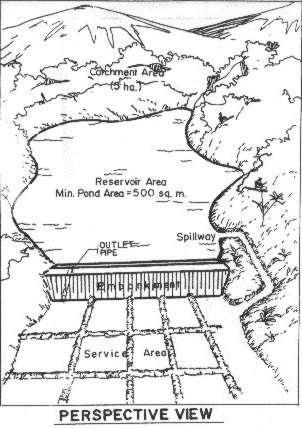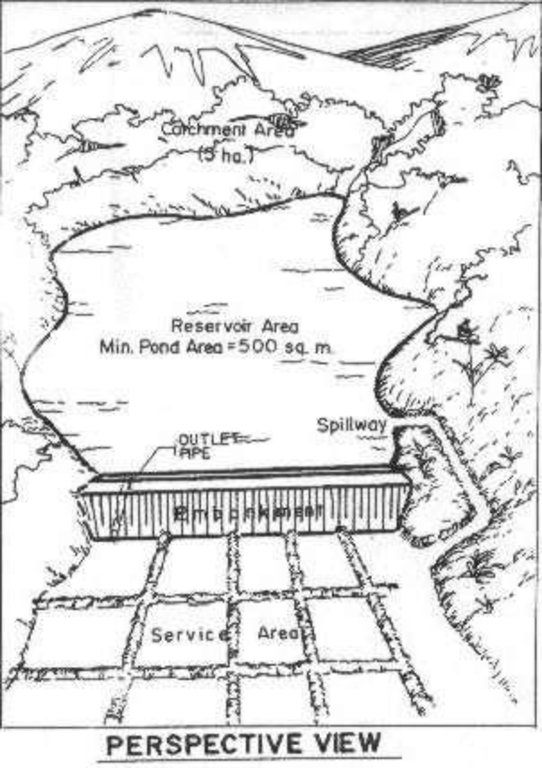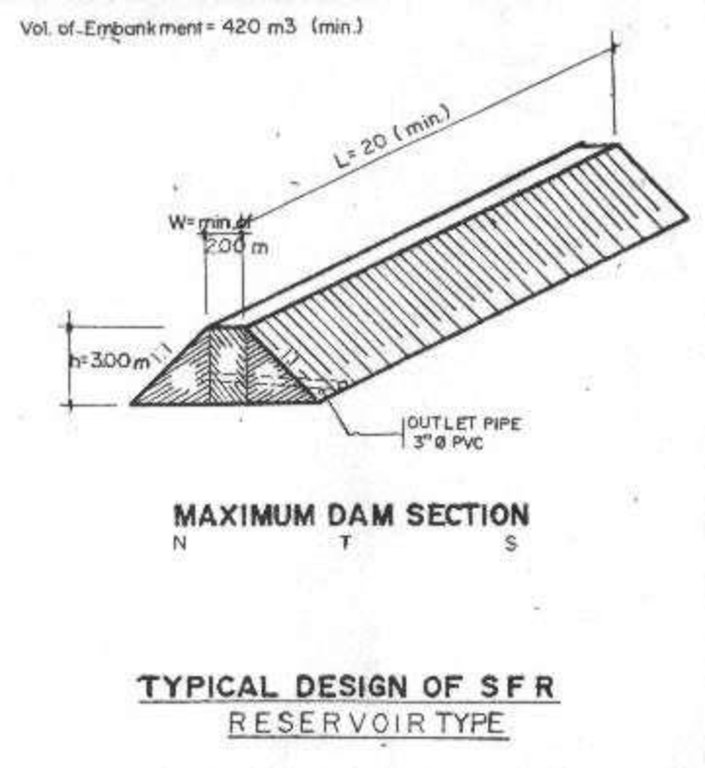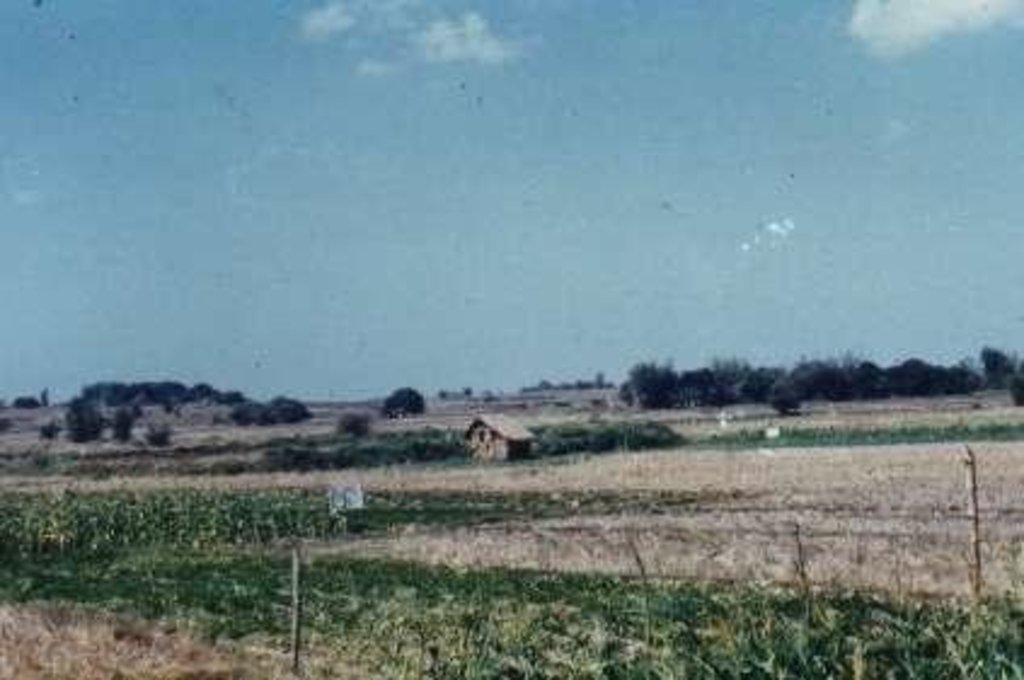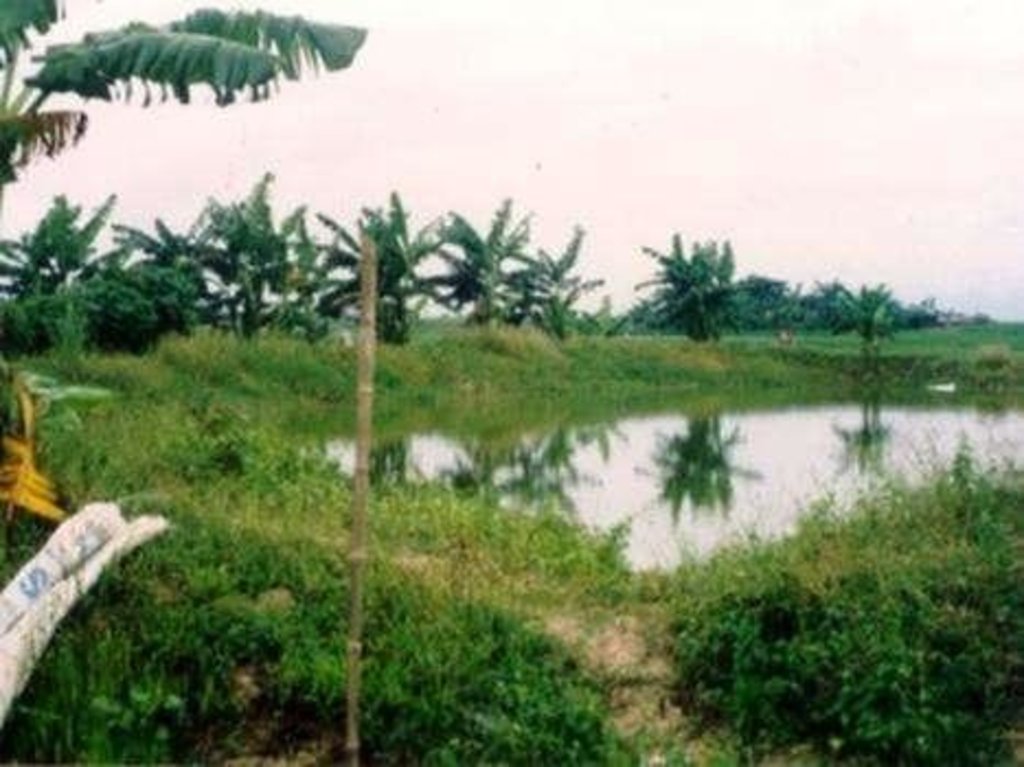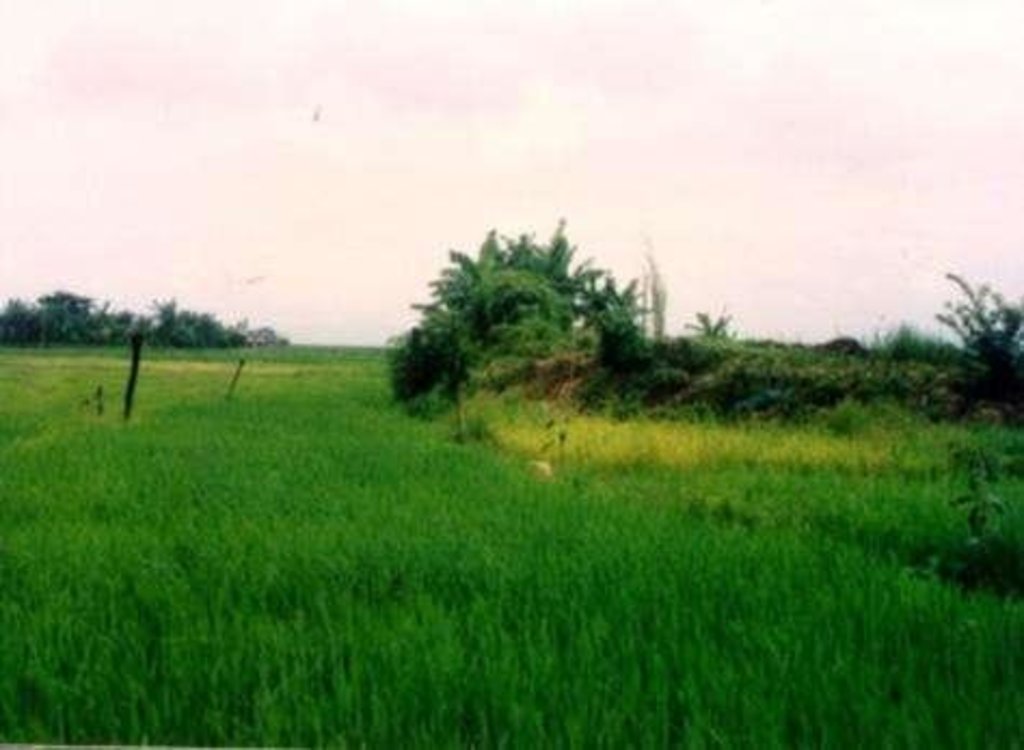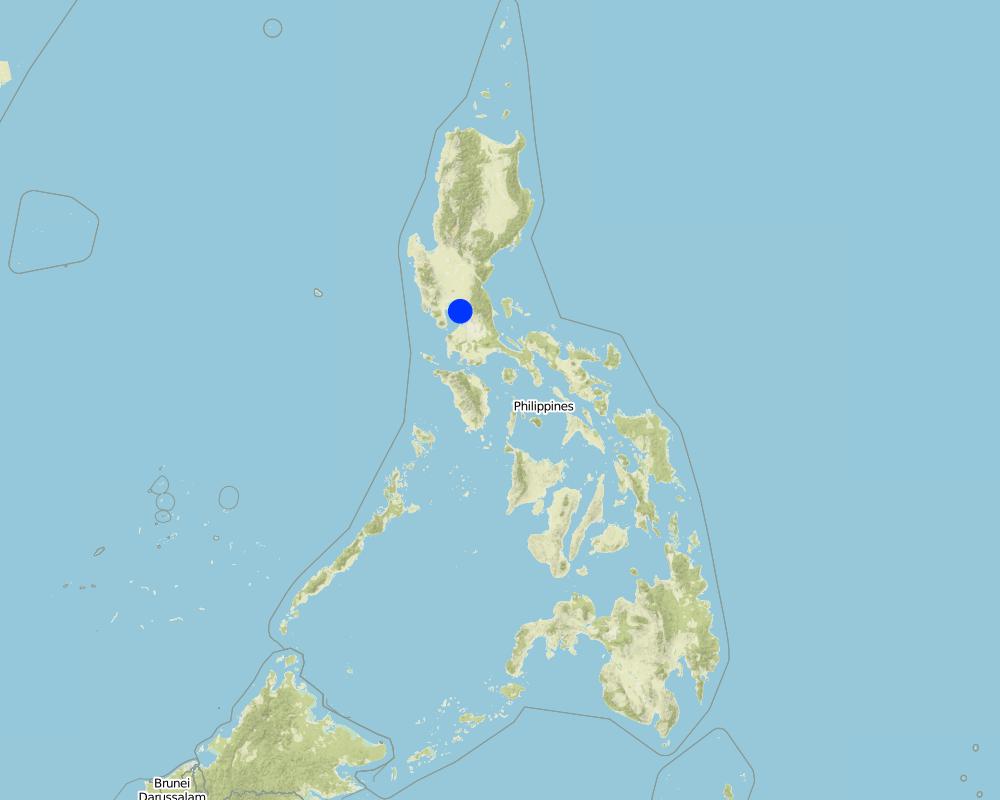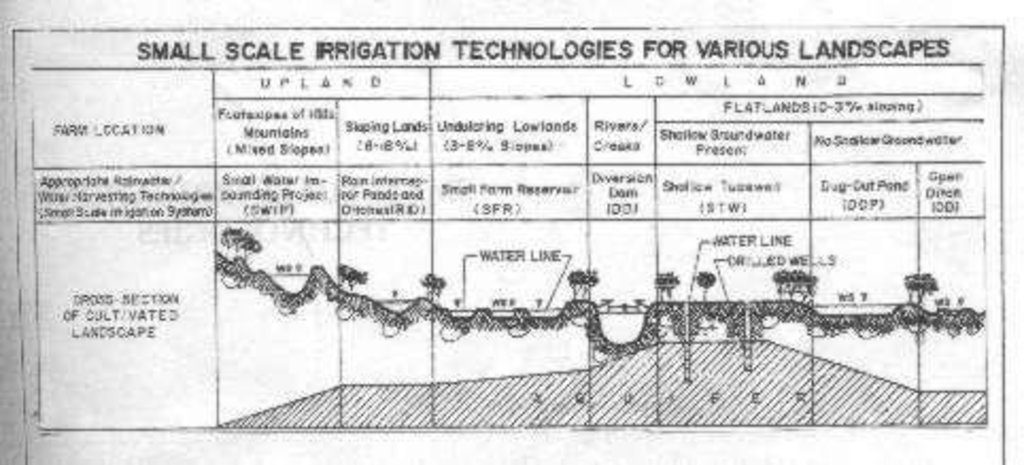Small Farm Reservoir (SFR) [菲律宾]
- 创建:
- 更新:
- 编制者: Philippine Overview of Conservation Approaches and Technologies
- 编辑者: –
- 审查者: Deborah Niggli, Alexandra Gavilano
Tabon
technologies_1102 - 菲律宾
查看章节
全部展开 全部收起1. 一般信息
1.2 参与该技术评估和文件编制的资源人员和机构的联系方式
SLM专业人员:
SANDOVAL TERESITA
Bureau of Soils and Water Management
菲律宾
SLM专业人员:
GICANA DOLORES MAE
Bureau of Soils and Water Management
菲律宾
1.3 关于使用通过WOCAT记录的数据的条件
编制者和关键资源人员接受有关使用通过WOCAT记录数据的条件。:
是
1.4 所述技术的可持续性声明
这里所描述的技术在土地退化方面是否存在问题,导致无法被认为是一种可持续的土地管理技术?:
否
2. SLM技术的说明
2.1 技术简介
技术定义:
The Small Farm Rerservoir is an earth dam structure used to trap harvest and store rainfall and water runoff.
2.2 技术的详细说明
说明:
The small farm reservoir (SFR) is a small water impounding earth dam structure to collect rainfall and runoff, designed for use in a single farm, and typically has an area of about 300-2,000 square meters. The embankment height above ground level is less than 4 meters. It can be easily constructed with a bulldozer or manual labor. Irrigation is done with PVC siphon pipes or pumps. SFR is used in rainfed-growing areas to provide supplemental irrigation to a wet season crop and partial irrigation to a dry season crop. Aside from irrigation and aquaculture, water in the reservoir could also be used for small scale livestock watering, wallowing areas for animals, e.g. ducks and picnic ground.
2.3 技术照片
2.5 已应用该技术的、本评估所涵盖的国家/地区/地点
国家:
菲律宾
有关地点的进一步说明:
Pangasinan, Nueva Ecija, Tarlac, Isabela, Bulacan, Ilocos Norte
具体说明该技术的分布:
- 均匀地分布在一个区域
如果不知道精确的区域,请注明大致覆盖的区域:
- 100-1,000 平方千米
注释:
Total area covered by the SLM Technology is 8884 m2.
The Department of Agriculture (DA) thru the Bureau of Soils and Water Management (BSWM) and different DA-Regional Field Units has embarked on intensive and fast-track implementation of the technology to conserve rain water during wet season to prevent flooding and to provide supplemental irrigation during dry season.
Map
×2.6 实施日期
如果不知道确切的年份,请说明大概的日期:
- 不到10年前(最近)
2.7 技术介绍
详细说明该技术是如何引入的:
- 通过项目/外部干预
注释(项目类型等):
From other areas with similar (areas where runoff can be collected and impounded and used for supplementary irrigation).
3. SLM技术的分类
3.1 该技术的主要目的
- 改良生产
- 减少、预防、恢复土地退化
3.2 应用该技术的当前土地利用类型

农田
- 一年一作
每年的生长季节数:
- 2
具体说明:
Longest growing period in days: 180, Longest growing period from month to month: May - Oct; Second longest growing period in days: 120, Second longest growing period from month to month: Nov - Feb
注释:
Major land use problems (compiler’s opinion): Very low yield of any crop due to inadequate moisture to sustain crop growth.
Major land use problems (land users’ perception): Unpredictable weather condition or occurrence of extreme climatic condition (La Nina or El Nino) constrained yield improvement.
3.5 该技术所属的SLM组
- 集水
- 灌溉管理(包括供水、排水)
- 引水和排水
3.6 包含该技术的可持续土地管理措施

农艺措施
- A3:土壤表面处理
- A5:种子管理,改良品种
A3:区分耕作制度:
A 3.2: Reduced tillage (> 30% soil cover)

结构措施
- S1:阶地
注释:
Type of agronomic measures: mixed cropping / intercropping, legume inter-planting, rotations / fallows, minimum tillage
3.8 防止、减少或恢复土地退化
具体数量名该技术与土地退化有关的目标:
- 防止土地退化
- 修复/恢复严重退化的土地
4. 技术规范、实施活动、投入和成本
4.1 该技术的技术图纸
技术规范(与技术图纸相关):
Uses of Small Farm Reservoir (SFR) system
Technical knowledge required for field staff / advisors: moderate
Technical knowledge required for land users: moderate
Main technical functions: control of dispersed runoff: retain / trap, control of concentrated runoff: retain / trap, water harvesting / increase water supply
Rotations / fallows
Material/ species: rice, corn, peanut
Minimum tillage
Material/ species: minimum tillage
Construction material (earth): The structure on earth dam
作者:
Bureau of Soils & Water Manage
4.2 有关投入和成本计算的一般信息
其它/国家货币(具体说明):
Phil. Peso
如相关,注明美元与当地货币的汇率(例如1美元=79.9巴西雷亚尔):1美元=:
43.0
注明雇用劳工的每日平均工资成本:
4.00
4.3 技术建立活动
| 活动 | 时间(季度) | |
|---|---|---|
| 1. | 1. Cleaning | onset of rains (May-June) |
| 2. | 2. Layouting/staking | onset of rains |
| 3. | 3. Rotovating or plowing | |
| 4. | 4. Basal fertilization | |
| 5. | 5. Planting | |
| 6. | 1. Site Investigation,Examination of soil profile | Start of Project |
| 7. | 2. Orienting the bulldozer operator on one technique of embankment and clearing the staked-out area | |
| 8. | 3. Scapping the top soil | |
| 9. | 3. Embankment construction |
4.5 维护/经常性活动
| 活动 | 时间/频率 | |
|---|---|---|
| 1. | 1. Irrigation | |
| 2. | 2. Minimum tillage | |
| 3. | 3. Planting | |
| 4. | 1. Weeding | /Monthly |
| 5. | 2. Fertilization | |
| 6. | 3. Irrigation | dry season /weekly |
| 7. | 1. Canal maintenance | as need arises |
| 8. | 2. Watershed protection and maintenance | continuing |
4.7 影响成本的最重要因素
描述影响成本的最决定性因素:
The availability of bulldozers in the site and access roads adds substantially to the cost.
5. 自然和人文环境
5.1 气候
年降雨量
- < 250毫米
- 251-500毫米
- 501-750毫米
- 751-1,000毫米
- 1,001-1,500毫米
- 1,501-2,000毫米
- 2,001-3,000毫米
- 3,001-4,000毫米
- > 4,000毫米
农业气候带
- 半湿润
Thermal climate class: tropics
5.2 地形
平均坡度:
- 水平(0-2%)
- 缓降(3-5%)
- 平缓(6-10%)
- 滚坡(11-15%)
- 崎岖(16-30%)
- 陡峭(31-60%)
- 非常陡峭(>60%)
地形:
- 高原/平原
- 山脊
- 山坡
- 山地斜坡
- 麓坡
- 谷底
垂直分布带:
- 0-100 m a.s.l.
- 101-500 m a.s.l.
- 501-1,000 m a.s.l.
- 1,001-1,500 m a.s.l.
- 1,501-2,000 m a.s.l.
- 2,001-2,500 m a.s.l.
- 2,501-3,000 m a.s.l.
- 3,001-4,000 m a.s.l.
- > 4,000 m a.s.l.
5.3 土壤
平均土层深度:
- 非常浅(0-20厘米)
- 浅(21-50厘米)
- 中等深度(51-80厘米)
- 深(81-120厘米)
- 非常深(> 120厘米)
土壤质地(表土):
- 中粒(壤土、粉土)
表土有机质:
- 中(1-3%)
- 低(<1%)
5.6 应用该技术的土地使用者的特征
生产系统的市场定位:
- 生计(自给)
- 混合(生计/商业)
非农收入:
- 收入的10-50%
相对财富水平:
- 贫瘠
- 平均水平
机械化水平:
- 畜力牵引
说明土地使用者的其他有关特征:
Population density: 10-50 persons/km2
5% of the land users are very rich and own 25% of the land.
10% of the land users are rich and own 25% of the land.
50% of the land users are average wealthy and own 40% of the land.
30% of the land users are poor and own 5% of the land.
5.7 应用该技术的土地使用者使用的平均土地面积
- < 0.5 公顷
- 0.5-1 公顷
- 1-2 公顷
- 2-5公顷
- 5-15公顷
- 15-50公顷
- 50-100公顷
- 100-500公顷
- 500-1,000公顷
- 1,000-10,000公顷
- > 10,000公顷
5.8 土地所有权、土地使用权和水使用权
土地所有权:
- 个人,未命名
- 个人,有命名
土地使用权:
- 自由进入(无组织)
- 个人
6. 影响和结论性说明
6.1 该技术的现场影响
社会经济效应
生产
作物生产
注释/具体说明:
rice production
木材生产
生产区域
其它社会经济效应
Fish production
注释/具体说明:
fish culture
社会文化影响
娱乐机会
注释/具体说明:
picnic ground
社区机构
注释/具体说明:
farmers are organized in Association
SLM/土地退化知识
注释/具体说明:
including soil fertility management
生态影响
土壤
土壤水分
土壤覆盖层
生物多样性:植被、动物
植物多样性
其它生态影响
Soil fertility
注释/具体说明:
have second crop
6.2 该技术的场外影响已经显现
水资源可用性
注释/具体说明:
increased ground water recharge
下游洪水
6.7 该技术的优点/长处/机会
| 编制者或其他关键资源人员认为的长处/优势/机会 |
|---|
| Individual farmers can own one or a number SFR, big areas of rainfed lowland areas are available during the dry season, SFR has multiple purposes as irrigation supplement, fish production, and recreation |
7. 参考和链接
7.1 信息的方法/来源
- 实地考察、实地调查
- 与土地使用者的访谈
(现场)数据是什么时候汇编的?:
30/08/2000
7.2 参考可用出版物
标题、作者、年份、ISBN:
Manual of Small Farm Reservoir (SFR). 1993.
可以从哪里获得?成本如何?
Philippine Council for Agriculture, Forestry and Natural Resources Research and Dev't (PCARRD), Technology and Application Institute (TAPI), Department of Science and Technology (DOST)
标题、作者、年份、ISBN:
The Philippine Agriculturist, Vol. 80 No. 3 &4/Romeo V. Labios, Virgilio Villancio, Jocelyn D. Labios, Artemio Salazar and Romeo E. delos Santos. July-Dec 1997.
可以从哪里获得?成本如何?
Publication Office, College of Agricultur, University of the Philipines Los Baños
链接和模块
全部展开 全部收起链接
无链接
模块
无模块


